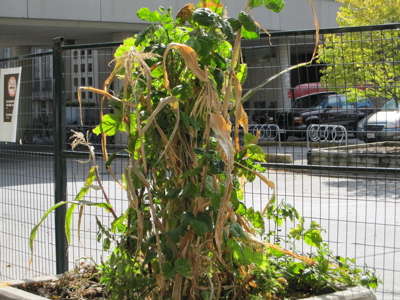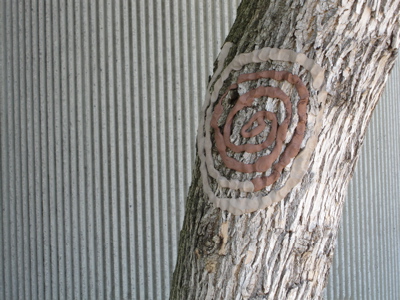Archive Page 2
nest video
Published October 21, 2009 able gardener 2 , art as research , eco-art , environmental art , escapelot , ottawa u , site videos , Uncategorized 1 CommentTags: art as research, eco-art, eco-art installation, eco-art video, ecoliteracy, faculty of education Ottawa u, guerilla garden, harvest, local art, lovingly handmade, nest, place-based pedagogy, process, university of ottawa
nido/nest installation
Published October 21, 2009 able gardener 2 , art as research , eco-art , environmental art , escapelot , Garden Posts , ottawa u , process , Uncategorized 1 CommentTags: domesticity, eco-art, escapelot, faculty of education Ottawa u, lovingly handmade, phenomenology, schoolyard gardens, university of ottawa
Arbor Genesis
Published October 16, 2009 art as research , eco-art , environmental art , escapelot , ottawa u , process , site videos , Uncategorized 2 CommentsTags: a question poses itself, blog video, eco-art, ecoliteracy, environmental art, faculty of education Ottawa u, guerilla garden, in situ, lovingly handmade, native, place-based pedagogy, postcolonial, process, research in place and space, site-specific art, thesis art, thesis blog, thesis video, university of ottawa
I found myself sitting in the basement archives of Ottawa U which is under the medical services building at Somerset E. and King Edward, in an attempt to get to know the site better, and as a response to Gruenewald’s questions: Who was here? What happened here? What needs to be conserved? What needs to be created? There are binders to consult in the archives that list possible contents of boxes going back about a hundred years. Not many listings have the word “environment” in them. “ecology” is not listed. I chose one box for the archivist to find for me; it was marked “Environment 1990”. On opening it I came face to face with the first file “SICK BUILDING SYNDROME” in block letters, a 20 page report on how putting ourselves in plastic envelopes within concrete boxes in order to reduce energy consumption is not the road to healthy environmental relationships.
The second thing I came across was this lovely invitation to a tree planting ceremony called Arbor Genesis: “Through the simple act of planting one tree on Convocation day, the 1990-91 Teacher Education graduates begin the creation of a small park of flowering trees for all to enjoy, beside Lamoureux Hall. Please plan on attending this special occasion with your family and friends.” and then there’s a quote from Jean Giono’s The Man Who Planted Trees: “But the transformation took place so gradually that it became part of the pattern without causing any astonishment”
We’ve decided to make a large nest in the tree, which I believe is this little flowering crab, with the left over plant matter from our garden. I’m told that “nido” is nest in Italian, and also means nursery school. I like this idea of “place”, a first place we all started from.
As far as I can tell, this is the only flowering tree that was planted. What was to be the arbor was planted with maple trees all at the same time at a later date.
able gardener 1 September Post
Published October 16, 2009 able gardener 1 , art as research , environmental art , escapelot , food issues , garden plan , Garden Posts , ottawa u 1 CommentTags: ecoliteracy, faculty of education Ottawa u, food, guerilla garden, native, schoolyard gardens, university of ottawa
The past few weeks, I am thinking about food security and the labour of those who cultivate the food we eat. I have been working as a TA for a course on Global Education and Social Justice for pre-service teachers and we have been discussing migrant justice issues… we have just finished readings about migrant farm workers. In particular I am thinking about Deborah Barndt’s work on the Tomasita Project, which is described in her book Tangled Routes. Barndt traces the path of the tomato from cultivation to packaging and marketing in North American supermarkets. Again, I think the Children’s Garden could draw links to these readings. I think many educators underestimate young children’s understanding of social, political and economic issues, and the kind of analysis they are capable of.
Resilience alliance
Published October 16, 2009 able gardener 1 , art as research , eco-art , environmental art , escapelot , food issues , ottawa u , process 4 CommentsDo corn, beans and squash as a companion planting which survives brutal construction zone conditions constitute a system with built in resiliences?
Chris Turner (p.37) author of “The Geography of Hope: A Tour of the World We Need” quotes Brian Walker of the Resilience Alliance: “With resilience …we kind of embrace uncertainty. And we try to say that the minute you get too certain, as if you know what the answer is, you’re likely to come unstuck. You need slack in the system. You need to have the messiness that enables self-organization in the system in ways that are not predictable. The best goal is to try to build a general resilience. Things like having strong connectivity, but also some modularity in the system so it’s not all highly connected everywhere. And lots of diversity”.
able 1 Spiral
Published October 16, 2009 able gardener 1 , eco-art , environmental art , escapelot , garden plan , Garden Posts , ottawa u , process 1 CommentAugust: Barb. Pat and I worked with clay, placing spirals around the garden. This visceral experience was fascinating… holding the clay facilitated a sense of wonder and appreciation for the growth of this garden… in spite of such adverse conditions, the garden continues to flourish… I am really moved by the resilience of these relatively small gardens surrounded by clattering and sputtering machines. I think it would make a wonderful metaphor for a children’s book… B’s project also reminds me of a children’s book I have been writing for some time. It is called The Spaghetti Garden and it is inspired by my friend who immigrated to Canada from Italy after the Second World War. She is an avid gardener and recounts stories describing the significance of her garden in her first years in Montreal. After9/11, she saw many parallels between how she was treated as an immigrant from a fascist society, and the emerging Islamaphobia at the time [of 9/11]. After watching the news, she would say to me: You have to remember that this was a time when most people in Montreal had never heard of spaghetti. Hearing her experiences as a young person in a new country made me think of her garden as a metaphor for resilience… and the resilience of the garden at Ottawa U reminds me of her stories.
able gardener 1 June post
Published October 16, 2009 able gardener 1 , escapelot , food issues , ottawa u , process Leave a CommentTags: faculty of education Ottawa u, food, postcolonial, schoolyard gardens, university of ottawa
The children’s garden is in the very early stages of growth and has an important presence near the education building. It is exciting to think about what will be cultivated and also the concept of it being a “post-colonial” garden. I really appreciate Barbara’s commitment to this project and her attention to the agricultural practices of first peoples. I am hopeful that a new generation of teachers will be attentive to issues of food security, and especially culturally-appropriate food. The post-colonial garden reminds me of an initiative in Toronto, the Afri-Can Food Basket, which was an important food security movement: http://www.africanfoodbasket.com/
One of the co-founders was a fellow student at the Faculty of Environmental Studies at York University and he inspired so many people with his commitment to the cultivation of, and access to, healthy and culturally-appropriate food. As I left Ottawa U. I walked past an elementary school near the campus and saw kids playing beside oak trees and small bushes. It was exciting to envision them in the process of cultivating food in the school yard. Undoubtedly they would bring important skills to such initiatives, in addition to learning new ones. I think that kids also bring an important element of wonder. Holding a seed, placing it deep in the earth and knowing that food will be cultivated is a realization that must elicit wonder!
Square Foot gardeners
Published October 16, 2009 able gardener 1 Leave a CommentTags: gardens, guerilla garden, lovingly handmade, schoolyard gardens
Last spring I worked with a bunch of neighbourhood kids through the local church to get a square foot garden growing. We ate our harvest two weeks ago in a party at my place. we had pesto, and noodles, tomatoes, and green beans. We did exactly no maintenance on the garden.
I was reminded of this when able gardener 1 gave me her notes to publish, and reminded of David Gruenewald’s (2007) questions in Place-Based Education in the Global Age Appendix ‘B’
Research on Place and Space
Published October 2, 2009 Uncategorized Leave a CommentTags: Bruce Janz, ecoliteracy, ecopedagogy, pedagogy of place, Research on Place and Space, research site, university central florida
I just discovered Bruce Janz’s website; Research on Place and Space.
It is a fantastic resource for anyone in any of the disciplines who might be researching aspects of place.
corn, beans & squashed
Published October 2, 2009 Uncategorized Leave a CommentTags: cafeteria, companion planting, corn beans and squash, faculty of education Ottawa u, faculty of education university of ottawa, food, guerilla garden, harvest, hodenoshone, local produce, lovingly handmade, no place, parking lot, postcolonial, three sisters, university of ottawa
The Hodenoshone Iroquois “Three Sisters” companion plantings opposite the wheatfield site did not fare well behind the construction fences and piled up with materials and equipment. Still, four ears of corn erupted and numerous green beans entwined the cornstalks. The squash leaves and vines were bountiful but constantly harassed and maltreated by street sweepers, infiltrated by lunch garbage from the construction workers and had the ends of vines regularly destroyed once they grew down to street level.
I feel quite bad about their neglect and abuse; they are alive and enliven the space with their unfurled stems and uncurled twisty bits. In an ironic “twist”, the boxes which are growing food, are located outside of what will be a new cafeteria which will no doubt not be supplied with local produce.






